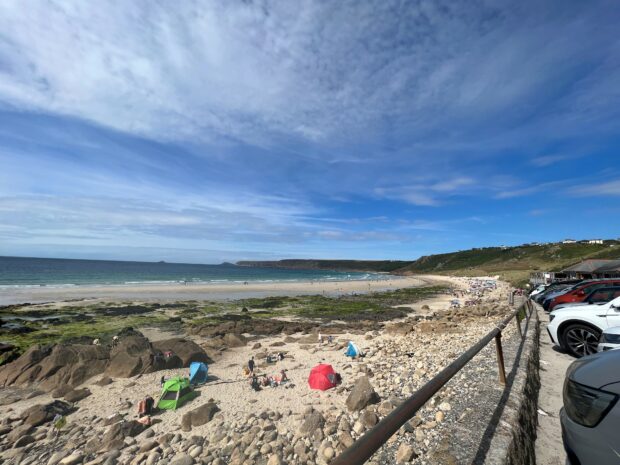
As the weather is warming and more people are heading outside to enjoy beaches, rivers and lakes, we’re starting our regular monitoring of bathing waters. Between now and the end of September, millions of people will head to bathing waters to relax and swim. We know that more and more people want to enjoy the benefits of bathing waters - they're important for both individual and community wellbeing, and support local economies.
The Environment Agency (EA) regularly tests water quality of designated bathing waters and makes information available to the public, via the Swimfo website.
So what does our monitoring actually involve?
Between now and September, we will take roughly 7,500 bathing water samples. We then send those samples off to be tested at our lab for two types of bacteria which show whether there is faecal matter in the water: E coli and intestinal Enterococci. We monitor for these two bacteria because they indicate that there are germs in the water which can make you ill.
These bacteria can be found in poo from a variety of sources - such as sewage, birds and other wildlife, pets and farm animals – and at varying levels.
We use the results of this regular testing to measure the cleanliness of bathing waters, and to make those results available on our Swimfo site so you can make an informed choice of which to visit. This helps you get the most out of your visit to a beach, lake or river by providing easy access to information about water quality.
You can use Swimfo now to find a designated bathing water near you; and we always recommend checking Swimfo when you’re on holiday or are planning a swim (or kayak, or paddleboard, or anything else where you’ll be on or near the water!)
Swimfo also includes a service called pollution risk forecasting, which lets you know that on some days, water quality can be temporarily reduced at some bathing waters due to factors such as rainfall, wind and high tides. Find out more about pollution risk forecasting here.
For more information on staying safe when using and enjoying any open water, head to Swim Healthy.
What does it mean when a bathing water is designated?
When a bathing water is designated, it means we monitor water quality there between now and September. Importantly, designation also means that information is provided to the public to help inform decisions on where and when to bathe.
Designated bathing waters are sampled by EA officers and at the end of the year the results of the samples will be used to give a bathing water a classification of Excellent, Good, Sufficient or Poor. Until they have been classified, we won’t know the quality or whether they are suitable for bathing. Designation does not guarantee clean water for swimming - rivers and seas are not sterile but changing and dynamic natural places.
It’s also important to remember that rivers and other open water locations that are not designated as bathing waters are managed for the purpose of protecting fish and wildlife, not people. So, health risks from using these locations may be higher than at designated bathing waters. If you do decide to swim in a river or open water, find out how to ‘swim healthy’ here Swim healthy - GOV.UK (www.gov.uk)
How do classifications work?
Samples taken by us throughout the bathing season help to produce an annual bathing water classification. Four years' worth of data is used to make a classification, allowing us to identify trends and target the appropriate pollution prevention measures. Having four years’ worth of data is important because water quality is dynamic, so short-term assessment alone won’t provide an accurate overall picture.
Each bathing water is given one of the following annual classifications:
- Excellent – the highest, cleanest class;
- Good – generally good water quality;
- Sufficient – the water meets the minimum standard;
- Poor – the water has not met the minimum standard. Work is planned to improve bathing waters not yet reaching Sufficient.
Once a year we then publish the official statistics which are available online.

7 comments
Comment by Ian posted on
There’s no river in England safe to swim in even if it has no sewage it still will be contaminated with rat urine and decomposing animals and fish. Just stay out or go to your local baths.
Comment by Peter Drake posted on
I am afraid that your comment is largely true. We need to make cleaning up our waterways a priority
Peter Drake science teacher Hexham Northumberland UK
Comment by VALERIE posted on
Cannot find anybody of people who recommend testing kitfor coliform bacteria pollution. Have tried Angling Trust and the Environment Agency. There are all sorts of kits available for testing but most of them do not cover coliform or e coli and when they do most come from China and I am against buying them in case they are useless copies!
Comment by eileenroffe posted on
Good morning, please contact Environmental Health who are with your local Council, https://www.gov.uk/find-local-council Eileen
Comment by Jay Andrews posted on
Deben Climate Centre might suggest the kit by the Deben river team in Suffolk. It needs a basic oven capable of maintaining 42deg, disposable syringes and agar plates sensitive to E.coli - you put 1ml of sample onto the plates, heat them for 24 hours, and the e.coli will develop colony forming units which you can count - these are the cfus/ml the EA test reflects.
Comment by Gabriel Mann posted on
How many freshwater bathing sites are there in the UK?
Comment by Paul posted on
Hi Gabriel
Thanks for your message, you can see bathing waters for the UK listed on the following gov.uk link - https://www.gov.uk/government/publications/bathing-waters-list-of-designated-waters-in-england - Hope this helps.
Regards
Paul
Customer Service Adviser